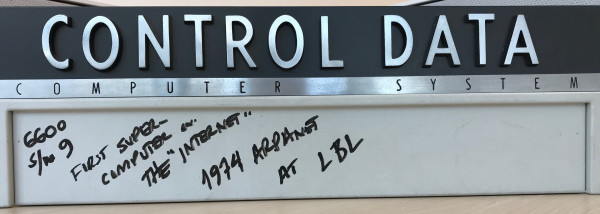Berkeley Lab Staff Lending Expertise, Computer History to SC18
November 6, 2018

This memory module from the Control Data Corp. (CDC) 6600 installed at Berkeley Lab is among the computing artifacts that will be on display in the DOE Booth (2433) at SC18.
As in years past, staff from Lawrence Berkeley National Laboratory (Berkeley Lab) will contribute significantly to technical program and the exhibition at the SC18 Conference being held Nov. 11-16 in Dallas, Texas.
The SC conference series is the largest international conference for high-performance computing, networking, data analysis and storage, drawing about 11,000 attendees from around the world.
Berkeley Lab staff will contribute to the conference's technical program by:
- Authoring or co-authoring seven technical papers
- Organizing or contributing to nine tutorials
- Organizing or presenting at 15 workshops
- Offering perspectives on three panel discussions
- Giving two presentations to vie for the ACM Gordon Bell Prize
- Sharing ideas at three Birds-of-a-feather sessions
- Presenting two technical posters
Lab staff will also contribute to the program in the U.S. Department of Energy booth (#2433) by giving two presentations, offering six demonstrations and hosting six informal roundtable discussions. The two featured talks will give updates on NERSC's next-generation supercomputer "Perlmutter" and the next-generation network architecture for ESnet:
- Nick Wright of NERSC will present “Introducing NERSC-9, Berkeley Lab's Next-Generation Pre-Exascale Supercomputer” at 1:45 p.m. Tuesday, Nov. 13.
- ESnet Director Inder Monga will discuss “ESnet6: Design of the Next-Generation Science Network” at 2:30 p.m. on Tuesday, Nov. 13.
In conjunction with the 30th anniversary of the first conference in the SC series, the DOE booth is featuring both a timeline showing breakthrough computing systems over the past seven decades, as well as a display of components from some of those machines. Berkeley Lab will be displaying:

Nameplate from Berkeley Lab's CDC 6600, first supercomputer connected to ARPANET.
- The nameplate and a memory module from a Control Data Corp. 6600, installed at Berkeley Lab in 1965. In 1974, the machine was the first supercomputer connected to ARPANET, an early network that provided the technical foundation for the Internet. Connecting an HPC system to the network helped pave the way for today’s ubiquitous networked computing.
- A compute module from a Cray T3E-900 installed at NERSC in 1997. Nicknamed MCurie, the 512-processor system was the proving ground for an ORNL-led materials research team to hone their new model of metallic magnet atoms. The team won the 1998 Gordon Bell Prize with a performance of 657 gigaflops and using a T3E at Cray's factory and achieved 1.02 teraflops, the first sustained performance of a scientific application to exceed 1 teraflops.
- A Cray XE6 Compute Blade from Hopper, a 153,408 processor-core Cray XE6 system installed at NERSC in 2010. The system ushered in the petaflops arena for the DOE Office of Science's broad user community of 3,000 users and 600 projects running at NERSC. Hopper debuted at No. 5 on the Nov. 2010 TOP500 list with a speed of 1.05 petaflops.
During the conference, ESnet staff will also participate in technology demonstrations with various partners.
And, as always, staff members will participate in a number of conference outreach programs for students and early career professionals.
About Computing Sciences at Berkeley Lab
High performance computing plays a critical role in scientific discovery. Researchers increasingly rely on advances in computer science, mathematics, computational science, data science, and large-scale computing and networking to increase our understanding of ourselves, our planet, and our universe. Berkeley Lab’s Computing Sciences Area researches, develops, and deploys new foundations, tools, and technologies to meet these needs and to advance research across a broad range of scientific disciplines.







 Instagram
Instagram YouTube
YouTube